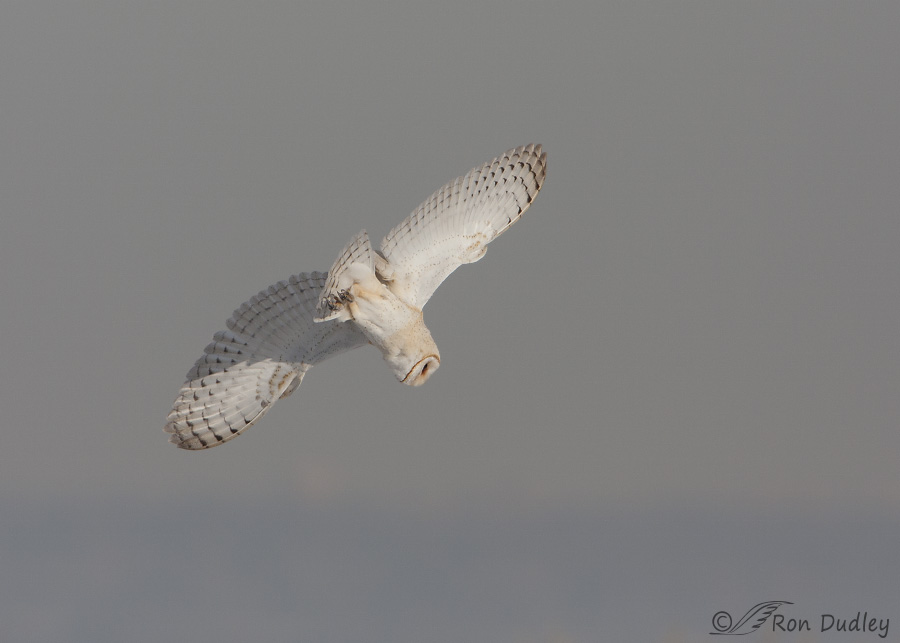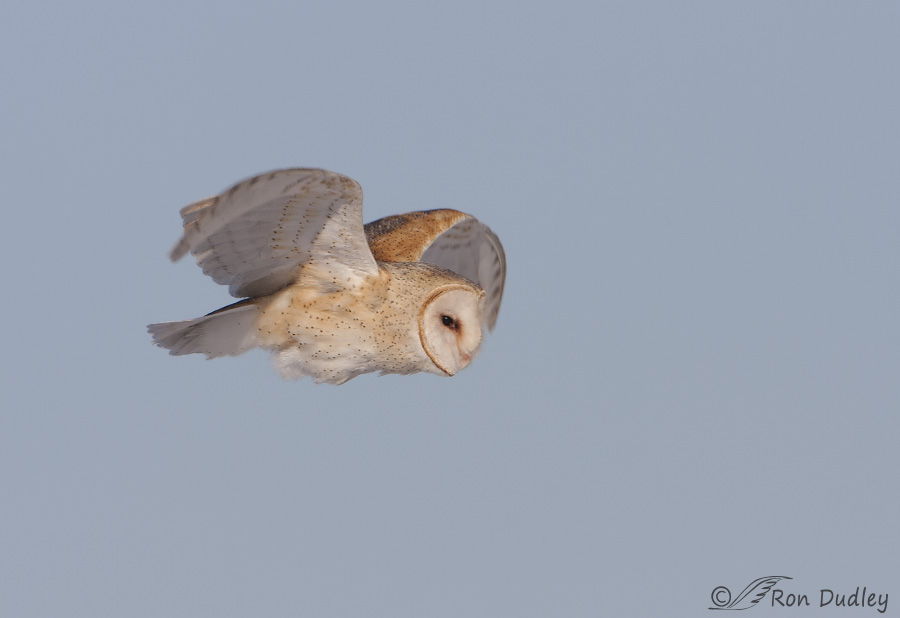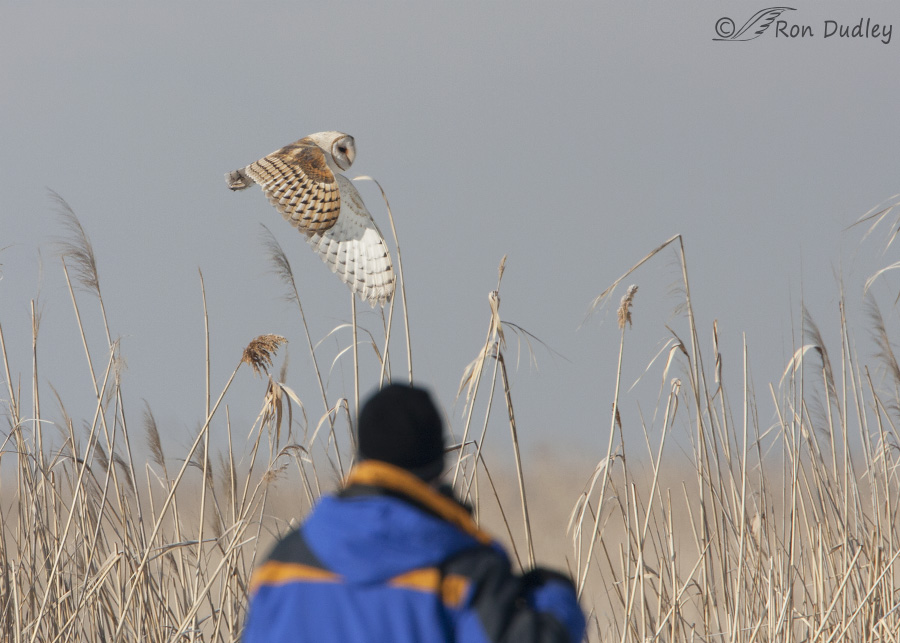If anything will give a bird photographer motivation to learn the techniques of photographing birds in flight it’s Barn Owls flying during daytime. This species is notoriously difficult to find flying in daylight but here in northern Utah we’re lucky because they often do so on very cold winter days.
In early 2008 I was still very much a novice at photographing birds in flight. Whenever I tried I usually couldn’t even find the damn birds in my viewfinder because I didn’t have the required skills so I mostly gave up even making the attempt. But then on my trips to Farmington Bay I occasionally noticed a photographer or two using tripods to photograph something in flight. They weren’t in areas where Bald Eagles and Northern Harriers are typically photographed so I watched them from a distance through my lens. They were photographing Barn Owls and those birds were flying during daytime! I had to have some of that action.
My first (and second, and third…) attempts to find the owls in my viewfinder and get them in focus were laughable but a couple of the other photographers had pity on me and provided tips and guidance. During the month of February, 2008 I eventually began to get some shots that interested me.
These are two of them, both taken on the morning of 2/15/08.

1/2500, f/8, ISO 400, Canon 40D, Canon EF 500mm f/4L IS USM + 1.4 tc, not baited, set up or called in
This owl is diving on prey. Some context to the image is provided by the faint horizon line at bottom – there are phragmites down there just out of frame. At the time I was thrilled to get this flight posture, even though we can’t really see the eye of the bird.

1/1250, f/10, ISO 400, Canon 40D, Canon EF 500mm f/4L IS USM + 1.4 tc, not baited, set up or called in
Earlier that same morning I caught this owl as it flew past me over the phrags (don’t even ask me what I was doing at f/10…).

1/2000, f/8, ISO 400, Canon 40D, Canon EF 500mm f/4L IS USM + 1.4 tc, not baited, set up or called in
While I was composing this post I kept debating whether or not I should include this image and its explanation but I’m just small enough to do it so here goes.
Three days after I took these first two images I photographed an incident that gave me some small satisfaction. The fellow in the blue coat is a very well-known bird photographer who came to Utah to shoot some of our legendary Barn Owls flying in daylight. He and a buddy (just out of frame to the right) had been gabbing away when this Barn Owl flew so close to them that they almost could have reached out and tickled it. But they missed the shots because they weren’t paying attention – in fact they didn’t even raise their lenses (they were shooting hand-held with what I believe were 400mm prime lenses) but they sure did notice what they missed.
I’ll admit to being petty enough to have snickered a little to see a professional bird photographer screw up an opportunity like the ones I had missed so many times before…
Images like these first two gave me hope and spurred me on. I spent countless hours practicing flight shots on gulls at local ponds and eventually my skills began to coalesce. I’m still working on them (it’s an endless process) but it’s kind of fulfilling to look back at some of those very early flight shots and see how far I’ve come, even though there’s definitely much further to go.
Ron


Fabulous images and great post. I’m always amazed at the photographers that gab away (often at high volumes) while waiting for a bird that has been seen frequenting a given area. This happened to us this February while photographing the great gray owl in Northern California. We couldn’t get away from them. We’d move away to a quiet spot and within a few minutes the blabber mouths would move over next to us and continue their discussions. Really unbelievable.
Yes.
And my nasty self (who is alive and well) would also have been smiling at the ‘professionals’ missing out.
Thank you for the images you share, day after day. And their back story. And the snippets of yours.
EC, usually I don’t wish bad luck on anyone but this time I’ll admit to a glimmer of satisfaction in seeing his fallibility.
Ron, You mentioned tripods in the beginning of your post. Is your present preference for raptors in flight: window-sill from truck , tripod with gimbal-head or hand-held? Thanks , John
John, My overall preference is to shoot from my truck. Each of the three options you mention has its advantages but you can’t shoot them well if you can’t get close and I can nearly always get closer when I use my pickup as a mobile blind.
Thank you for showing us the beginning of your journey as a Behavior Bird Photographer. It helps a lot to know how you did it, the mistakes you have made and how you learned from them.
Your blog is a source of daily inspiration.
Thanks very much, Jorge. That means a lot.
Agree with Roger 100 percent! Insert the string of ridiculously repetitive superlatives here.
Personally, I love the first shot because it shows how they dive (or how that one individual dove at that prey that time…LOL!).
It’s not ONLY a matter of practice (although that’s an absolutely CRITICAL part), but it’s also a matter of being out there consistently (read LOTS and LOTS of hours of paying full attention) and the personality that strives for perfection. Each shot is a brand-new experience, each unique and each requiring a perfect response to a different set of variables. It’s that constantly different thing that draws me to falconry (and previously to racing). It’s the constant ever-changing challenge that must be met! I love that.
Again, thank you so much for sharing!
Laura, as you well know some folks enjoy a challenge and the satisfaction that comes from growing and improving as they learn to respond to it well. Others don’t like to be pushed – they prefer to coast along in their comfortable rut. Different strokes I guess.
They aren’t willing to pay the price of time, effort and patience!
I don’t mind the price at all…the payoff is HUGE, and as my dad used to say, “Anything worth doing is worth doing well.” And he prepared me that failure on the way to success is a very good thing.
Great shots, interesting information!
Charlotte
Thanks, Charlotte.
HA! You’d think they’d know better! It’s the shots I’ve missed that I remember most clearly (and dearly). I bet that one will haunt them for a looooong time! I hope they got some good ones later. I really, really love the unusual angle/view (a bystander vole’s eye view)of the bird in the first…almost as good as being there…these birds are SO beautiful!!!
“It’s the shots I’ve missed that I remember most clearly (and dearly)”
Boy, that’s for sure, Patty, I once photographed a coyote, up close, as it very nearly snagged a juvenile Chukar out of the air. But I cut off part of the Chukar and the image was soft. I spit nails over that one.
Even worse is when you’re faced with “THE perfect picture” but don’t even have a camera with you!!! That REALLY HURTS!!! Those are memories it seems impossible to erase…..
The evil one is playing with me again…sorry!
The last picture, shows the beauty of flight, but really the owl itself with all its color and with that background what a picture.
I’ve always liked that image Steven, different as it is…
Glad you showed the last image with explanation – no one is “perfect” for sure. Even the first image is great in my opinion! The “practice” part is still an issue for me – lazy I suppose as I don’t want to go through ALL those photo’s yet also know that’s the price to get the shots we REALLY want.
Even the first image is great in my opinion! The “practice” part is still an issue for me – lazy I suppose as I don’t want to go through ALL those photo’s yet also know that’s the price to get the shots we REALLY want.  Barn owls are weird, unusual, beautiful creatures that we don’t have around here.
Barn owls are weird, unusual, beautiful creatures that we don’t have around here.
You’re absolutely right, Judy – culling images is a PITA. However, the piper must be paid…
When in the field, be ever vigilant is the motto!
How can one be vigilant when shooting with a buddy, unless the buddy is of the same mind!
Many thanks for the explanation and the last photograph, point well taken!!
“How can one be vigilant when shooting with a buddy, unless the buddy is of the same mind”
That’s why Mia and I shoot so well together, Dick. Plus she’s a better bird spotter than I am (better eyesight) so she more than carries her own weight.
Yes!! You should have shown this last image!! It is a critical, and important example of why, when in the field, we must be constantly
aware of what is going on around us, and be ready to react in a moments notice when the action starts. For those of my friends who
want to do bird photography, and especially get into getting shots of flying birds, I stress the need to “practice, practice, and then
practice some more.” Shooting digital does not cost a single penny (once the gear has be paid for) so why not practice shooting
everything that moves? I think too, we all need to be reminded that excellent images can be created with some of the older gear.
Here you are using a Canon 40D, which is not the latest, or most expensive of the Canon bodies, yet you produced a great image,
which illustrates a very important concept… The skill of the photographer is often more important than the cost of the equipment
he/she is using. Put the latest gear in the hands of a “duffer,” and you will still get mediocre images. You Ron, are a “Pro!” No one
who sees your images could ever doubt those words. Keep on inspiring all of us… ;-)))
Amen!
Thanks, Roger. And you’re right about older gear. Even though the 40D only produces 10 MP files they still look pretty good, even when cropped.